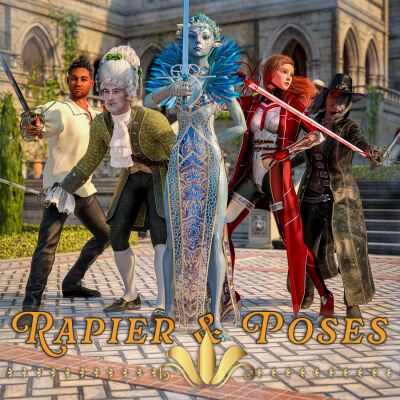! REPORT
From the Kitchens of the Grandess
3D Render by Aci KayThe Grandess’ Feasts of the Immaculate are splendid indeed. The high society of Galgare’s influence, and the lucky few sovereigners plucked personally from their ramshackle houses by the Grandess herself, treated to a banquet of unrestrained indulgence and sensory overwhelm. Delicacies from the farthest reach of Emparis and beyond comprise exotic displays of colour and scent, as aromatic steam raises a haze of phenomenological delight throughout the hall.
The starters are small, easy to eat with discretion. Steamed leaves wrapped around hennel, tiny meats cured with peppervisk, gelled fruits and husked coruna. Crystal glasses are topped up with aluva every turn – that thick, pigmented juice that coats the tongue and arouses its papillae, bolstering every feaster’s sense of taste and smell. It has the side effect of misting the mind, half-lidding the eyes, and turns one’s surroundings into a blur of shape, colour and transient form. Eat, says the mind, chew, bite, roll food across the tongue, crack thin shells of cocoa and rice against the tooth and infuse the saliva with strands of turespic and grains of sanola… then let it sink into a new pool of aluva and start again.
The Feasts always begin cordially. Aloofly by the elite, nervously by the commoners. But by the second bell it becomes a beastly affair. Knives and spoons are discarded for hands, and the dishes become meatier, bloodier, satisfying to tear into with the nails and rip between teeth. The criss-crossed sinews of plain boars are a particularly gruesome dish to see consumed; Feasters work together to extract still-warm fibres from the charred beasts’ open middles and soak them greedily in bowls of spiced blood and gingered crisk.
By the fourth bell the mood has mellowed, as the accumulative effects of the aluva begin to seep deeper into the body. The senses begin to dull now, as do inhibitions, and so the dessert course becomes a sensual affair. The gels and pastes are intensely sweet, the marbled cheeses and hyce-cooked olives overly bitter, the toadskin and port sediment tongue-buzzingly bitter, as feasters swap flavours between each other and dine from rather softer surfaces.
But the highlight of the night is always the final bell, when the plates of azurin are brought out. The feasters only think they’re full, for they have room for one, and one more. Those small, simple berries, nostalgic to all, but forever a forgotten memory. The aluva will have finally worn away from the tongue, flowing only through the veins and synapses, and so the azurin’s gently bitter flavour, and the pop of its taut skin, brings tears to the eye.
The feast ends in wailing, in sweet sobs of lost time, and yet it will be the best memory many of the feasters ever have.
There are tales of the poorer folk refusing to eat after returning to their homes. Perhaps they wish not to sully their tongues with the wooden gnarls of their own moulding bread, or simply fail to see the point in continuing an existences devoid of the colours and spectacular of the Feast.
Perhaps they should have followed the example of the Grandess. For though she graciously takes her place at the head of the High Table as host, not a scrap of food nor drop of aluva touches her tainted lips. It is a self-imposed test of sorts, a promise to her heritage. Only when her blood is free from the shackles of that ancestor, will she partake in the feast.
And partake she will.
----------------------------------
About a year ago I wrote a commission for someone that was very into sensory food literature. It was like ↑ this, but.... 10 000 words. And honestly, I kinda dig it now.
The starters are small, easy to eat with discretion. Steamed leaves wrapped around hennel, tiny meats cured with peppervisk, gelled fruits and husked coruna. Crystal glasses are topped up with aluva every turn – that thick, pigmented juice that coats the tongue and arouses its papillae, bolstering every feaster’s sense of taste and smell. It has the side effect of misting the mind, half-lidding the eyes, and turns one’s surroundings into a blur of shape, colour and transient form. Eat, says the mind, chew, bite, roll food across the tongue, crack thin shells of cocoa and rice against the tooth and infuse the saliva with strands of turespic and grains of sanola… then let it sink into a new pool of aluva and start again.
The Feasts always begin cordially. Aloofly by the elite, nervously by the commoners. But by the second bell it becomes a beastly affair. Knives and spoons are discarded for hands, and the dishes become meatier, bloodier, satisfying to tear into with the nails and rip between teeth. The criss-crossed sinews of plain boars are a particularly gruesome dish to see consumed; Feasters work together to extract still-warm fibres from the charred beasts’ open middles and soak them greedily in bowls of spiced blood and gingered crisk.
By the fourth bell the mood has mellowed, as the accumulative effects of the aluva begin to seep deeper into the body. The senses begin to dull now, as do inhibitions, and so the dessert course becomes a sensual affair. The gels and pastes are intensely sweet, the marbled cheeses and hyce-cooked olives overly bitter, the toadskin and port sediment tongue-buzzingly bitter, as feasters swap flavours between each other and dine from rather softer surfaces.
But the highlight of the night is always the final bell, when the plates of azurin are brought out. The feasters only think they’re full, for they have room for one, and one more. Those small, simple berries, nostalgic to all, but forever a forgotten memory. The aluva will have finally worn away from the tongue, flowing only through the veins and synapses, and so the azurin’s gently bitter flavour, and the pop of its taut skin, brings tears to the eye.
The feast ends in wailing, in sweet sobs of lost time, and yet it will be the best memory many of the feasters ever have.
There are tales of the poorer folk refusing to eat after returning to their homes. Perhaps they wish not to sully their tongues with the wooden gnarls of their own moulding bread, or simply fail to see the point in continuing an existences devoid of the colours and spectacular of the Feast.
Perhaps they should have followed the example of the Grandess. For though she graciously takes her place at the head of the High Table as host, not a scrap of food nor drop of aluva touches her tainted lips. It is a self-imposed test of sorts, a promise to her heritage. Only when her blood is free from the shackles of that ancestor, will she partake in the feast.
And partake she will.
----------------------------------
About a year ago I wrote a commission for someone that was very into sensory food literature. It was like ↑ this, but.... 10 000 words. And honestly, I kinda dig it now.
From the Kitchens of the Grandess
[+] Give Award
Wed, Nov 15, 2023 92
92
 2
2
 92
92
5
 2
2Software Used
Artist Stats
Member Since:
Karma:
Followers:
Likes Received:
Karma:
Followers:
Likes Received:
May, 2020
2,515
53
1,176
2,515
53
1,176
Gallery Images:
Wallpaper Images:
Forum Topics:
Marketplace Items:
Wallpaper Images:
Forum Topics:
Marketplace Items:
106
2
6
3
2
6
3

83

15

2

1



















































